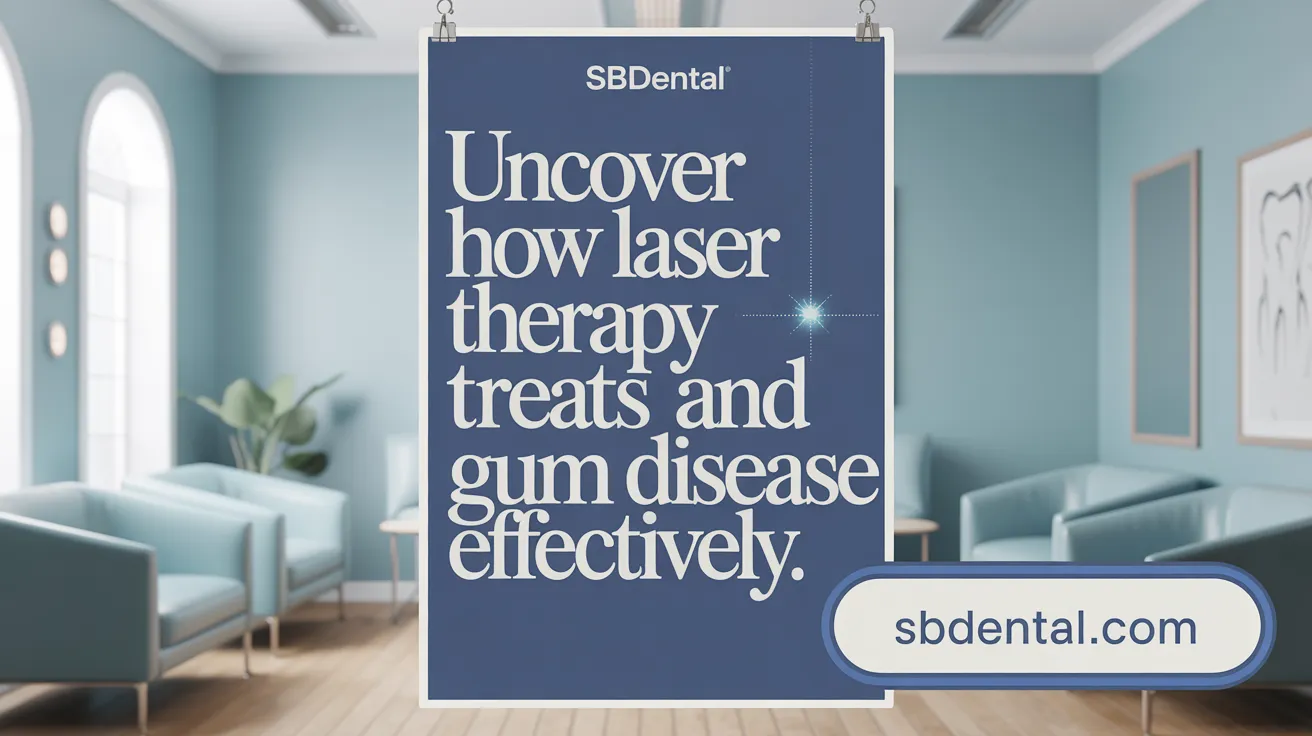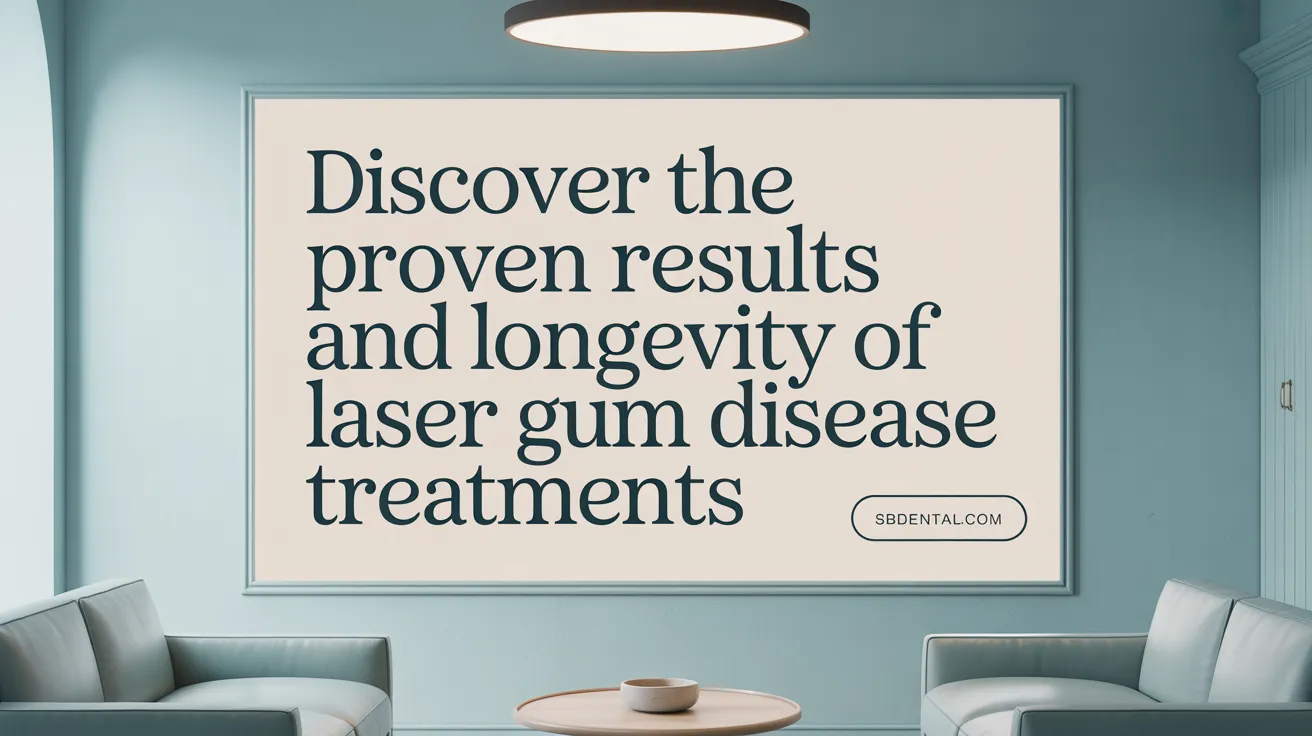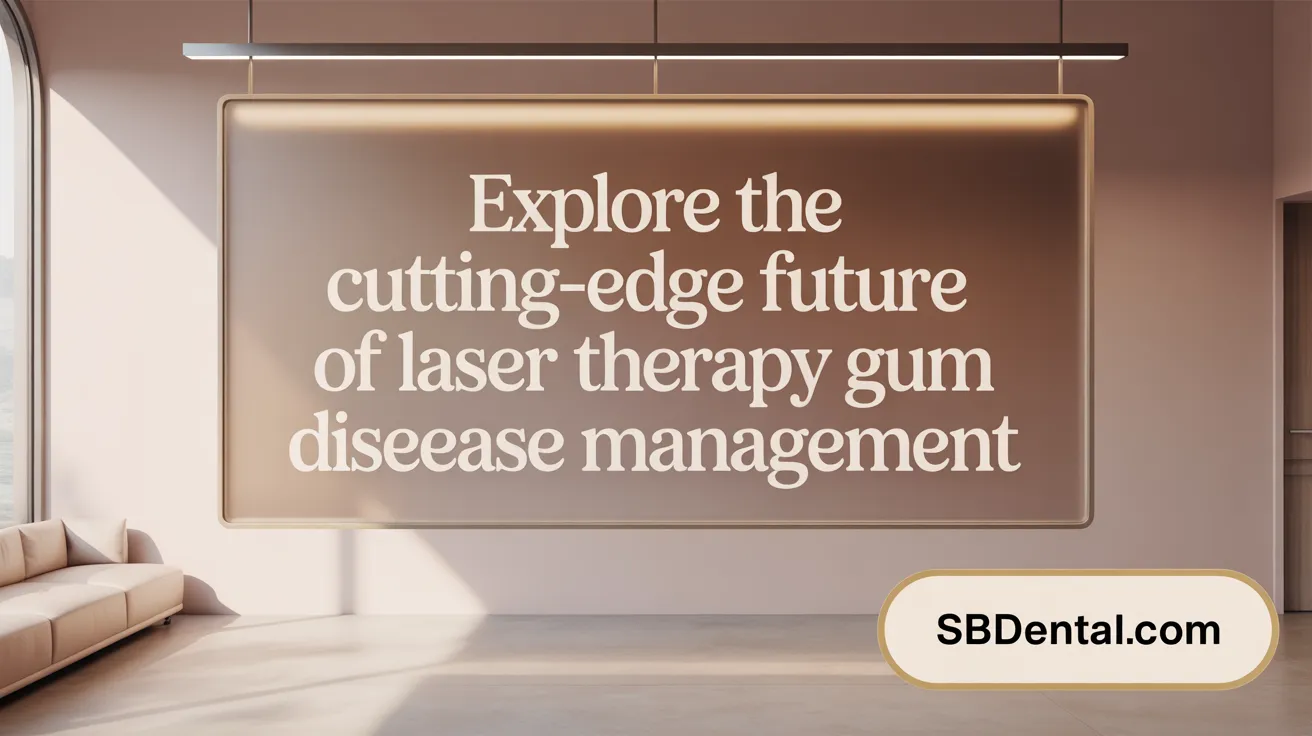Why Laser Periodontal Therapy Marks a New Era in Gum Disease Treatment
Gum disease remains a prevalent oral health challenge, affecting nearly half of adults over 30 and linked to serious systemic conditions such as cardiovascular disease and diabetes. Traditional treatments, while effective, often involve invasive procedures, longer recovery times, and significant discomfort. Enter gentle laser periodontal therapy—a groundbreaking, minimally invasive treatment that harnesses the precision of laser technology to treat gum disease efficiently, safely, and comfortably, offering renewed hope for patients seeking modern, effective solutions.
Understanding Laser Periodontal Therapy and Its Mechanism

What is laser periodontal therapy and how does it work?
Laser periodontal therapy is a minimally invasive dental treatment designed to combat gum disease by using concentrated laser light. This light precisely targets and removes infected or inflamed gum tissue as well as harmful oral bacteria. Unlike traditional surgery, the laser distinguishes diseased tissue based on its color and blood content, allowing it to vaporize only the affected areas. This selective removal helps preserve healthy gums and reduces trauma and bleeding during the procedure. Learn more about Laser Periodontal Therapy.
What types of lasers are typically used in periodontal therapy?
Different laser types are utilized based on their properties and intended applications in periodontal care:
- Nd:YAG and diode lasers: Primarily used in soft tissue procedures, such as the Laser-Assisted New Attachment Procedure (LANAP), these lasers target pigmented bacteria and damaged tissue.
- CO2 lasers: Employed for rapid soft tissue removal and achieving hemostasis, offering precise cutting with minimized bleeding.
- Er:YAG lasers: With high affinity for water and hydroxyapatite, they are suitable for nonsurgical periodontal therapy, effectively removing diseased tissue without harming bone or healthy gums.
These lasers are chosen to optimize precision, safety, and promote faster healing. For more on the types of dental lasers and uses, see this resource.
What is LANAP and why is it significant in laser therapy?
LANAP stands for Laser-Assisted New Attachment Procedure, an FDA-approved laser treatment for advanced gum disease. It selectively targets diseased gum tissue, removing bacteria and infected tissue while preserving healthy areas. This minimally invasive approach stimulates regeneration of gum tissue, bone, periodontal ligament, and cementum. Compared to conventional surgery, LANAP reduces patient discomfort, encourages bone growth, minimizes gum recession, and enhances long-term periodontal health. Its ability to promote natural healing while preventing tooth loss makes it a significant advancement in laser periodontal therapy.
Advantages of Gentle Laser Therapy Over Traditional Treatments

What are the main benefits of laser periodontal therapy compared to traditional gum surgery?
Laser periodontal therapy stands out for its minimally invasive gum disease treatment, which directly reduces discomfort during and after the procedure. Unlike traditional surgery that often requires general anesthesia, laser therapy frequently needs little to no anesthesia, easing patient anxiety and physical strain.
The recovery time after laser periodontal treatment is notably shorter, commonly about one week, which is faster than with conventional methods. Patients typically experience less bleeding and swelling, thanks to the laser's ability to sterilize the treatment area. This sterilization also lowers the risk of post-treatment infections, contributing to smoother healing.
One of the biggest advantages is the precision lasers offer. Diseased gum tissue and bacteria are carefully targeted, while healthy tissues are preserved. This precision helps minimize common surgical side effects such as gum recession and tooth sensitivity.
Who are ideal candidates for laser periodontal therapy?
Ideal candidates include those with moderate to severe gum disease, especially patients experiencing deep periodontal pockets or chronic gum inflammation. Individuals suffering from recurring infections or those with medical conditions like diabetes or autoimmune disorders, which can complicate healing, also benefit significantly from this gentle laser periodontal therapy.
Moreover, laser periodontal therapy is particularly suited for patients who experience dental anxiety. The less invasive, quieter, and often anesthesia-free nature of the procedure makes it a comfortable option for those who might otherwise avoid necessary gum treatment.
By combining less discomfort, faster healing, and targeted treatment, laser gum disease therapy caters well to a broad range of patients seeking effective gum disease care with minimal disruption to their daily lives.
The Laser Periodontal Therapy Procedure and Healing Process

What does the laser periodontal therapy procedure typically involve?
Laser periodontal therapy typically begins with an initial consultation and thorough evaluation by a dental professional. Local anesthesia, often topical, is administered to ensure patient comfort during the procedure. A specialized dental laser is then applied to the affected areas, where it precisely removes diseased gum tissue and effectively kills harmful bacteria in the periodontal pockets. The laser also seals blood vessels, which greatly reduces bleeding during the treatment. This minimally invasive approach promotes natural healing processes and encourages reattachment of healthy gum tissue to the tooth structure.
What should patients expect after laser gum therapy in terms of recovery and post-treatment care?
After the procedure, patients can anticipate some mild symptoms such as soreness, tooth sensitivity, slight swelling, minor bleeding, and changes in gum color. These symptoms usually subside within a few days to a week. Post-operative care is crucial and involves avoiding brushing or flossing directly on the treated area at first. Instead, rinsing with warm salt water or a prescribed antimicrobial mouthwash is recommended to keep the area clean and promote healing. Eating soft, non-irritating foods while steering clear of tobacco products helps facilitate recovery.
Recovery timeline and follow-up appointments
Healing typically progresses quickly, with many patients returning to normal activities within days. The full recovery period averages about one week but can vary depending on individual health and extent of the treatment. Regular follow-up visits are scheduled to monitor gum health, assess healing, and provide any necessary supportive care, helping to ensure long-term periodontal stability.
Precautions and symptom monitoring
Patients are advised to watch for unusual signs such as persistent or worsening pain, excessive bleeding, pus discharge, swelling, or fever, as these might indicate infection and need prompt dental attention. Maintaining good oral hygiene and adhering to all post-care instructions enhances treatment success and minimizes risks.
Clinical Effectiveness and Long-Term Outcomes of Laser Therapy

How effective is laser therapy in treating periodontal disease?
Laser therapy, especially the Laser Assisted New Attachment Procedure (LANAP), demonstrates a high efficacy in treating periodontal disease. Studies report a remarkable 99.9% oral bacteria kill rate with laser treatment, effectively targeting infection within periodontal pockets. This precision allows the laser to remove diseased gum tissue while preserving healthy tissue, promoting regeneration of gum tissue and even bone. Compared to traditional treatments like scaling and root planing or conventional gum surgery, laser therapy results in less trauma, minimal bleeding, and faster healing. Clinical data reveal that approximately 98% of patients treated with laser therapy avoid further disease progression for up to five years post-procedure, highlighting its potential for sustained gum health.
Comparison with traditional treatments
Laser therapy offers several advantages over conventional periodontal procedures. The minimally invasive gum treatment nature means no scalpels or sutures are required, limiting tissue damage and patient discomfort. Recovery time is typically shorter, often within one to two days, versus several weeks for traditional surgery. Additionally, the sterilizing effects of laser treatment reduce infection risk and lower the need for antibiotics. Laser treatment’s precision in targeting only diseased areas contrasts with the broader removal involved in standard surgery, leading to decreased gum recession and preservation of healthy tissue.
Longevity and recurrence rates
Patients undergoing laser periodontal therapy experience longer-lasting results compared to traditional methods. The technique promotes bone regeneration and gum tissue reattachment through laser therapy, which helps stabilize teeth and reduce pocket depths. Consequently, patients often require fewer follow-up treatments and exhibit lower recurrence of periodontal disease. The laser’s ability to stimulate stem cells to produce new connective tissue also supports durable periodontal stability.
Research findings and FDA approval
LANAP and similar laser treatments are FDA-approved for periodontal therapy. Numerous clinical studies back their effectiveness, demonstrating significant improvement in clinical attachment levels and pocket depth reduction. Although research continues to evolve, existing evidence supports laser therapy as a safe and beneficial alternative or adjunct to conventional periodontal care. The technology is now integrated into many dental practices worldwide, reflecting growing confidence in its use.
Limitations and suitability concerns
Despite its benefits, laser therapy may not be suitable for all cases. It is less effective in very severe periodontal disease where pocket depths are exceedingly large due to limited laser penetration depth. Its availability is also constrained by the high equipment costs and limited access in some regions. Patients requiring extensive surgical intervention may need traditional approaches instead. Moreover, while laser therapy is beneficial for most moderate to advanced cases, careful patient evaluation is essential to determine the best treatment modality.
Future Directions and Integrative Approaches in Gum Disease Care

What does the future hold for laser therapy in periodontal treatment?
Laser technology in periodontal care is advancing rapidly, improving precision and becoming more portable and patient-friendly. Integration of laser therapy with traditional methods such as scaling and root planing, along with adjunctive techniques like photodynamic therapy, is leading to better clinical outcomes. The ability of laser treatment to stimulate bone regeneration is significant as it can reduce tooth loss and enhance long-term gum health. As research progresses and standardized protocols develop, laser therapy is expected to become more widely adopted in general dental practices, expanding its accessibility and effectiveness.
How does laser therapy fit into comprehensive gum disease management?
Laser therapy is a valuable supplement to the broader management of gum disease. It works alongside professional dental cleanings, medications, and diligent home care routines. The minimally invasive nature of laser treatment aligns with patient-centered care by minimizing pain and recovery time, thus reducing lifestyle disruption. Moreover, by controlling gum inflammation and bacterial infection effectively, laser therapy contributes to lowering systemic health risks associated with periodontal disease, such as cardiovascular and respiratory illnesses.
Advances in laser technology and dental practice integration
Modern laser devices, including FDA-approved systems, offer enhanced targeting of diseased tissue without harming healthy gums. This refinement supports quicker healing and less discomfort, making laser therapy an attractive option within dental clinics. As dental providers integrate lasers more seamlessly into their practice, patients benefit from efficient, tailored treatment plans.
Combination with traditional treatments and home care
Laser therapy does not replace but complements traditional periodontal treatments. It is often combined with scaling and root planing and supported by appropriate antibiotic or antimicrobial rinses. At-home oral hygiene practices remain crucial, helping maintain the treatment benefits achieved with laser therapy.
Potential for bone regeneration and reduced tooth loss
Unique among periodontal treatments, laser therapy, especially procedures like LANAP, promotes regeneration of bone and connective tissue. This biological stimulation is key in preserving natural teeth, reducing the need for extractions and costly replacements.
Patient-centered care and systemic health benefits
Laser periodontal therapy is especially suitable for patients seeking less invasive options or those with health conditions that complicate traditional surgery. By reducing inflammation and infection, it may also mitigate wider systemic health risks linked to gum disease, supporting overall wellness.
Emerging trends and ongoing research
Ongoing studies are refining laser treatment parameters and exploring its integration with digital dental technologies. Continued research is enhancing understanding of laser use in promoting tissue repair and long-term disease control, signaling a promising future for this cutting-edge periodontal care approach.
Embracing Laser Technology for Healthier Gums and Smiles
Gentle laser periodontal therapy represents a transformative advance in treating gum disease, marrying cutting-edge technology with patient comfort and clinical effectiveness. By precisely targeting diseased tissue, minimizing trauma, and stimulating natural healing, laser therapy offers faster recovery and improved long-term oral health outcomes. As research progresses and laser adoption widens, this modern approach promises to redefine periodontal care—helping countless individuals preserve their natural teeth, maintain healthier gums, and enjoy enhanced overall well-being with less pain and fewer complications.
